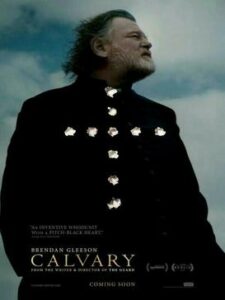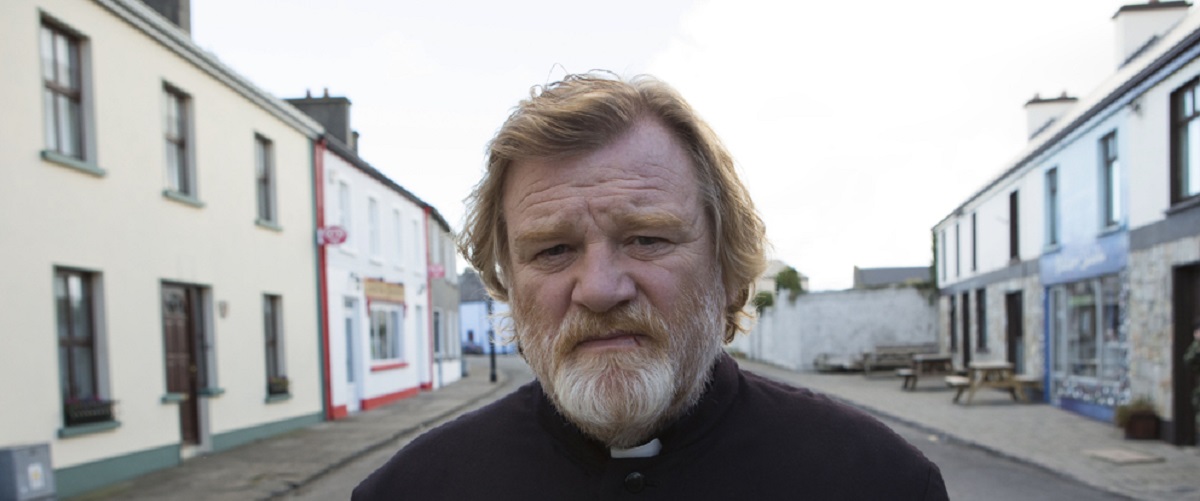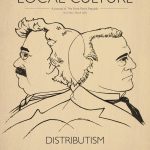[Editor’s note: this review contains spoilers].
Emmitsburg, MD. In his 1990 essay, “The Work of Local Culture” (the same essay which gave Front Porch Republic’s magazine its name), Wendell Berry argued that a flourishing human community exerts a “centripetal force” upon those who live within it. This centripetal force adheres the community together, “holding local soil and local memory in place,” and eventually draws those who leave a local culture for the sake of intellectual or professional enrichment back to the community. In modernity, however, the centripetal force of human culture has shifted from local societies to the cities, “which have drawn irresistibly into themselves both the products of the countryside and the people and talents of the country communities.” Although the healthy local communities of old and the often dehumanizing urban communities of today both exercise centripetal forces, for Berry, their sources are not the same. The prospect of materialistic gain and comfort is the centripetal force of the cities, luring young people away from the countryside and their local communities with promises of wealth and power. The centripetal force of the local soil is the family, “the nuclei of home and community”; local communities form on the basis of families being useful to one another, not merely in the sense of utility, but of self-giving sacrifice, love of neighbor, and dedication to the enrichment of place. The centripetal force of the family is, of course, love.
 While Berry’s conclusions about the decline of life-giving local cultures are framed within an American context, novelist Jon Hassler in his 1985 novel A Green Journey made similar observations about Irish culture. Written amidst Ireland’s “Troubles,” Hassler’s novel provides an American outsider’s perspective on the mounting tensions between the numerous cultural forces at odds with one another in his contemporary Ireland: urban vs. rural; the conservative IRA vs. liberal media and popular culture figureheads; encroaching American consumerism vs. small, declining family businesses; and, most concerningly for Hassler, Ireland vs. the Catholic Church and the Church vs. itself.
While Berry’s conclusions about the decline of life-giving local cultures are framed within an American context, novelist Jon Hassler in his 1985 novel A Green Journey made similar observations about Irish culture. Written amidst Ireland’s “Troubles,” Hassler’s novel provides an American outsider’s perspective on the mounting tensions between the numerous cultural forces at odds with one another in his contemporary Ireland: urban vs. rural; the conservative IRA vs. liberal media and popular culture figureheads; encroaching American consumerism vs. small, declining family businesses; and, most concerningly for Hassler, Ireland vs. the Catholic Church and the Church vs. itself.
Hassler’s characters are disturbed by the declining place of the Church in Ireland and Hassler clearly wanted his audience to share in their apprehension. The novel consistently portrays the Church and its parish priests as the centripetal force of Irish local culture, the binding agent that keeps the disparate, conflicting parts of Ireland coherent and in communion with each other. However, Hassler also observes that the centrality of the Church to local Irish cultures is a double-edged sword: priests, in playing such an important role in their communities, are forced into a life of isolation because of the reverence the members of their flock (especially their older parishioners) show them. The near-deification that comes from being at the center of the community causes these priests—at least, in Hassler’s novel—to collapse in on themselves. It is lonely, not at the top, but in the center.
Hassler’s novel warns that, in forgetting that its priests are human beings made for community, the Church, especially in Ireland, risks the alienation of their clergy and the total dissolution of local culture. Hassler wrote A Green Journey years before the extent of the Church’s sexual abuse crisis in Ireland was known, but his warnings presciently anticipate the wave of anti-clerical sentiment that pervades contemporary Irish communities in the wake of these abuses. John Michael McDonagh’s 2014 film Calvary fulfills Hassler’s dire predictions, showing the total cultural dissolution that results from the loss of clerical centripetal force. However, both Hassler and McDonagh conclude their stories with the hope that, in the absence of the clergy, faithful everyday Christians can rebuild the lost soil of local culture through faith and forgiveness.
* * *
A Green Journey begins in Staggerford, Minnesota, a fictional town which serves as the main setting for Hassler’s novels, and centers on Agatha McGee, an elderly and perpetually single Catholic school teacher who served as an ancillary character in Hassler’s first and most famous novel, Staggerford. After reading a letter to the editor celebrating the orthodoxy and fidelity of the Church in Ireland in the conservative Catholic magazine The Fortress, Agatha strikes up a years-long and intimate (though platonic) correspondence with the letter’s writer, an older man from a town outside Dublin named James O’Hannon. Frustrated with feeling useless after retirement and wanting to meet James (for whom she is clearly nursing romantic feelings) in-person, Agatha agrees to travel to Dublin with a tour group from her local diocese on a trip led by the diocese’s new head and Agatha’s nemesis, the progressive Bishop Baker.
When she arrives, Agatha meets James and the two share what seems to Agatha like a romantic evening together. On their way to a restaurant, James shows her parts of Dublin, a city pock-marked by old wounds of cultural conflict and new scabs of encroaching globalism. (In a particularly evocative passage, Hassler has James observe that the General Post Office, site of the 1916 Easter Rising by Irish republicans against British rule, is flanked by a Burger King and “its matching piece,” a McDonalds.) Although the evening goes well, Agatha notices James’s reticence in spending time with her. After the two tour the city together the next day, James suddenly and cryptically departs, telling Agatha that he will continue to write to her. Furious, Agatha travels to James’s tiny home village, the fictional Ballybegs (which literally means “small town”), to intercept him at his local parish’s Sunday Mass and get an explanation for his disappearance. There, she discovers to her horror that James himself is the pastor. He has been a priest for decades. This revelation leaves Agatha heartbroken; she withdraws from her Minnesotan travelling companions and heads into Dublin alone for several days.
Bishop Baker susses out what happened to Agatha from one of her friends and travels to Ballybegs to confront James on his scandalous behavior. Although he knows Agatha dislikes him, Baker also wants to win Agatha over to his side so he can use her to help him downsize and close the parochial school where she used to work. When Baker arrives, he finds, contrary to his expectations, that James is not a scoundrel but tremendously lonely, with nothing but alcohol, copies of The Fortress, and a cat to keep him company. James seems to survive entirely on beefsteaks and whiskey, taking little care in his rectory’s cleanliness. Baker realizes that he has seen this behavior even in his own diocese’s priests: “the messy house and the haphazard diet stood in the bishop’s mind for the absence of a companion in the life of every priest. Two people living together never seemed to tolerate quite so much squalor as a man might live in by himself.” In James, Baker sees a horrible truth about the clerical life: “All priests are pathetically alone, he thought, myself included.”
When Baker chides James for keeping his priesthood secret from Agatha, James retorts that Baker fails to understand the Church in Ireland. Despite the anti-clericalism in the urban centers, the people of Ballybegs have treated James like a prince. “‘Out on the street,’” James declares, “‘the priest gets nothing but worshipful smiles and esteem . . . I’ve lived a lifetime as prince and I’m not finding it a pleasant thing to look back on. It’s kept me separate from my people . . . Prevented me from being close to anyone.’” Although Baker perceives that James has been drinking and tries to leave, James demands that the bishop stay, as he’s been the first real company James has had in the rectory for years. James attempts to explain to Baker why he shared his life with Agatha through his letters:
My flock is a loveable flock. I tell them that from the pulpit. At Christmas, I come right out and say it . . . [but] even though I have everything a priest would want, there’s more to life than a priest would want, never mind what they teach you in the sem. You know it as well as I—we’re men apart. I’m standing up there at Christmas, saying I love my people, and I’m wishing I had a friend among them. I’m held in esteem by them all, but what’s esteem worth in the end?
Baker suddenly comprehends that he has stayed with James “not because he needed to hear more, but because James so obviously needed a listener.” James’s life at the center of Ballybegs’s local culture has left him almost divinized by his people yet totally isolated.
Although Agatha and James move towards reconciliation by the end of the novel (the true healing of their friendship makes up the plot of Hassler’s sequel novel Dear James), Agatha and Baker recognize the state of spiritual turmoil facing Ireland as they depart. As they drive away from Dublin on a rainy night amidst a pro-IRA demonstration, Agatha looks back and sees the protestors, “a small mass of humanity packed in a tight, immovable knot” become “an abstract, colorless etching of a nation enduring—as well as prolonging—its timeless, crippling pain.”
But these, the narration continues, “were city impressions.” For Agatha, “refreshment came from the land.” Agatha finds the enduring “‘essence of the Emerald Isle’” not in the spiritually centrifugal forces of the city, but in the salubrious centripetal forces of the countryside. But even here Hassler leaves the situation ambiguous. Hassler’s novel portrays conflicting ideas of culture and identity as threatening to boil over into outright violence in the urban centers of Ireland (an observation proven right by the events of the 1990s) and suggests that the salve for this strife could be found in rural areas. However, Hassler also notes that these local cultures revolve around priests whom the Church has essentially left to their own devices at best and abandoned at worst. Hassler’s novel presages that without further formation, support, and intentional clerical community building from the Church—and the laity’s empathy and recognition that their shepherds are human beings too—the priests who make up the foundations of Ireland’s local cultures threaten to crumble under the weight of unreasonable expectations.
* * *

Hassler’s ominous predictions are vindicated in McDonagh’s Calvary. Set on the rural coast of Sligo in northwest Ireland, the film depicts a week in the life of the local parish priest, Fr. James Lavelle (Brendan Gleeson). In the movie’s first scene, an unseen parishioner, while in confession with Lavelle, threatens to murder the priest in a week’s time. The parishioner had been sexually abused by a priest as a child and wants to kill Lavelle to revenge himself on the Church for its apathy and hypocrisy; he has chosen Lavelle as victim of his vengeance not because Lavelle is a bad priest, but because he is a good one; the culprit reasons that his death will hurt the Church more. Lavelle agrees to meet the man in a week’s time. Although Lavelle knows who is threatening him, the audience does not. Even after his bishop tells him that he is not bound by the seal of Confession, Lavelle refuses to turn the man into the police.
While the film ostensibly functions as a darkly comical murder mystery on a first viewing, the death it emphasizes throughout is not Lavelle’s but the community’s. Local butcher Jack Brennan (Chris O’Dowd) is abusing his lascivious wife Veronica (Orla O’Rourke) for her affair with African immigrant Simon (Isaach de Bankolé). Eccentric ex-banker Michael Fitzgerald (Dylan Moran) has been abandoned by his family and his servants. Brendan Lynch’s (Pat Shortt) pub is being foreclosed on. Milo Herlihy (Killian Scott), a mentally disabled young man, is struggling with violent feelings towards women due to his lack of romantic abilities. Even Lavelle’s altar server Mícheál (Mícheál Óg Lane) has been sneaking communion wine between masses.
Nothing holds Lavelle’s flock together except for their mutual disdain and in some cases outright hatred for the Church. Almost every character treats Lavelle as a scapegoat for the sins, historical or otherwise, that they see in the Church—not only pedophilia, but also anti-Semitism, racism, hypocrisy, and even collaboration with the Nazis—while jeeringly acknowledging Lavelle as a “good priest.” When Fiona (Kelly Reilly), Lavelle’s adult daughter from his marriage before he joined the priesthood, comes to town after a failed suicide attempt, several of the townsfolk make fun of her for her “classic error” of cutting her wrists horizontally rather than along the vein. Over the course of the film, Lavelle is frequently mocked, his church is burned down, his dog is killed; he also has a crisis of faith, gets into a bar fight, and is rewarded for his work with violence and derision at every turn. As Fiona says after one of the villagers mocks Lavelle, “Do you have to put up with that kind of shit on a regular basis?”
With the loss of local culture comes the loss of meaning in the lives of Sligo’s citizenry. In addition to Fiona, Lavelle discovers over the course of the film that almost everyone he has encountered—including Jack, Veronica, Michael, Milo, Veronica, Lavelle’s American friend Gerald Ryan (M. Emmet Walsh), and homosexual prostitute Leo (Owen Sharpe)—is either depressed or actively suicidal. (Moments before the confrontation that will end in his own death, Lavelle literally walks another one of his parishioners back from the brink of a seaside cliff.) All these people clearly need Lavelle’s help, even though they frequently reject it when he offers. The priest at the center of this local Irish culture, who might have been publicly idolized less than thirty years before, is now ostracized by his flock while he attempts to minister to them.
Though it does not shy away from the direness of this cultural collapse, Calvary also lays out a solution: a return to the virtues. Midway through the film, Lavelle encounters Teresa (Marie-Josée Croze), a French woman, as he provides last rites to her husband. He dies shortly after from injuries sustained after being hit by a drunk driver. Teresa asks Lavelle how people typically react when he ministers to the dying. Lavelle recounts: “Situations like this one, people are shocked. The randomness of it. They curse God. Curse their fellow man. Lose their faith in some cases.”
“Lose their faith?” Teresa replies. “It must not have been much of a faith to begin with, if it is so easy for them to lose it.” Teresa goes on to say that she and her husband “loved each other very much . . . And [his death] is not unfair. That is just what happened. But many people don’t live good lives. They don’t feel love. That is what is unfair.”
Teresa returns at a critical juncture near the film’s climax. Lavelle meets her in an airport, as he contemplates fleeing his scheduled meeting with his would-be murderer. She is taking her husband home to be buried in Rome. When Lavelle asks her how she has been doing, she replies “sometimes I think I cannot go on. But I will go on.” It is Teresa’s stalwart fidelity to her faith that convinces Lavelle to return and try to seek reconciliation with his attacker.
In addition to faith, Calvary suggests forgiveness as a means of communal healing. Lavelle and Fiona converse several times throughout the film about the morality of her suicide attempt. Fiona reveals that she took her father’s pursuit of a vocation following her mother’s death as a betrayal and an abandonment. In their final exchange, right before his confrontation with the killer, Lavelle calls Fiona. “I think there’s too much talk about sins, to be honest,” he tells her. “And not enough talk about virtues.”
“You might be right,” Fiona retorts. “What would be your number one?” He answers, “I think forgiveness has been highly underrated.” The two then mutually forgive each other.
In the film’s closing scene, Fiona visits her father’s killer in prison. The two sit across from each other, separated by glass. While the killer looks shocked that she is there, Fiona tearfully picks up the phone, harkening to her father’s last conversation with her and Lavelle’s own initial encounter with the murderer in the confessional at the film’s beginning. Like her father, like Christ, she is ready to forgive.
What happens next is not shown to the audience; likewise, the impact Lavelle’s death had on his community is left ambiguous. What is certain, however, is that these small actions, Teresa’s heroic fidelity and Fiona’s heroic forgiveness, have an enormous impact. They reintroduce love, the rejected love that Lavelle offered his persecutors and the missing and life-giving centripetal force, back into the community. While A Green Journey showed that Irish culture in the mid-1980s was being held together by the clergy, Calvary suggests that the renewal of Irish culture today (and perhaps even renewal of local culture throughout the whole world) is in the hands of the laity and their capacity to return Christ-like faithfulness and love to the center of their communities.






1 comment
Keith w Petersen
Very nice summary and conclusion on Cavalry. I happened to come upon it one evening and was surprised at it’s message — forgiveness and radical faith in the face of being ignored which is worse than being hated.
Cheerspp
Comments are closed.